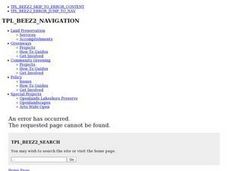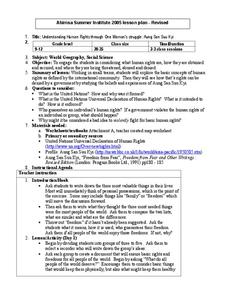Curated OER
Characteristics of Reptiles Lesson Plan
First graders draw pictures of reptiles and share them with the class describing the characteristics of the reptile. In this reptiles lesson plan, 1st graders determine if animals in pictures are reptiles or not.
Curated OER
Weather Tools
Learners explore Earth science by participating in a weather identification activity. In this scientific instrument lesson, students identify several weather related tools such as the weather vane, thermometer and rain gauge. Learners...
Curated OER
Insects: Grasshoppers
Students examine grasshoppers as they practice following instructions. In this biology lesson plan, students identify the characteristics of grasshoppers and the functions of grasshoppers' external body parts.
Curated OER
Earth Pockets
Students identify the Earth's natural resources. In this Earth science lesson, students read the book The Great Kapok Tree and discuss types of natural resources. Students use categories such as wood, paper, and trees and list items that...
Curated OER
Dogfighting Hurts Animals
Students discuss dogfights and relate caring for a baby to caring for their animal. In this dogfighting lesson, students view video about dogs forced to fight and relate to parenting skills. Students become familiar with ways to help...
Curated OER
Cell Growth and Division
Students explore the cell cycle. They examine why the cell cycle is necessary. Students discuss the processes of interphase and mitosis. They explore the general phases of mitosis; prophase, metaphase, anaphase and telophase.
Curated OER
Animal Homes
Students explore how an animal's relationship to its habitat affect the animal's survival. They discuss animal habitats and the animal's relationship to that habitat through the food chain, life cycle, community, and balance of nature....
Curated OER
Endangered Organism Project
Students examine how different organisms meet the characteristics of life. They study specific endangered species and what caused their endangerment. They vcomplete a power point research project.
Curated OER
What Beautiful Caterpillars!
Second graders investigate the life cycle of the caterpillar. They create a caterpillar habitat and care for it. Students make daily observations that are recorded in a writing journal. During the process of observation the students...
Curated OER
Temperate Forests vs. Wetlands
Students compare and contrast the temperate forest and wetlands by researching them in groups. For this forest lesson plan, students identify the economic, ecological, and social benefits of each.
Curated OER
2D Concept Visualization: Cell Organelles Presentation
Students create simple 2D concept driven visualizations of cells and cell organelles and organize them into an effective presentation.
Curated OER
Understanding Life System: Growth and Changes in Plants
Third graders research ways in which plants are essential to humans. In this Global Peace instructional activity, 3rd graders participate in tasks, such as creating a propaganda poster. Students may watch the film, The Lorax, as a...
Curated OER
Is Government Necessary?
Learners investigate the purpose of Congress and determine how it affects them. They explain what life would be like without government.
Curated OER
Map Me a Paragraph
There are so many great reading strategies. In this lesson, learners practice decoding. They break down two paragraphs to analyze and determine main ideas and details. They each observes ways to model as they map their paragraphs.
Curated OER
Fire Fighting
Students consider the effects of a wildfire on prairie life. They explore the ways that plants regenerate after a fire and create fictional plants that have adapted specifically to the prairie environment. They share models of their plants.
Curated OER
Westward Expansion
Students locate California and New York on a map and explore available means of travel in the 19th century. Students explore the role of trade in pioneer America and simulate various barter transactions.
Curated OER
Civil War Diaries
Fifth graders examine excerpts from a diary of a Confederate soldier and his experiences in a Union prison camp. After receiving character cards, they write diary entries from the perspectives of their Civil War identity. As an...
Curated OER
We the People Level 2
Students explore U.S. history by participating in a government activity. In this Constitution instructional activity, students identify the role government plays in our society and the differences the British colonies had in the early...
Curated OER
Hermit Crabs in the Classroom
Young scholars interact with hermit crabs in the their classroom. In this hermit crab lesson, students handle and observe hermit crabs while learning about their habitats and how to treat animals. They watch how the animals move and...
Curated OER
Understanding Human Rights Through One Woman's Struggle: Aung San Suu Kyi
Students analyze human rights in the international community. In this human rights lesson, students explore the United Nations, and the Declaration of Human Rights. Students read about Aung San Suu Kyi and watch a video about human...
Curated OER
Physics of Sound: How We Hear Sounds
Students examine the way they hear sounds. In groups, they label and identify the functions of the different parts of the ear. After reading a book by Helen Keller, they research the mechanisms of sound and how sounds are different...
Curated OER
Now you see it....Now you Don't
Students investigate the biodegrading process of packing peanuts. In this biological process lesson, students conduct an experiment to see how quickly packing peanuts biodegrade. Students check the process each day and record their results.
Curated OER
Physics of Sound: How We Hear Sounds
Second graders identify the different function and parts of the ear. In this physics lesson, 2nd graders explain how we hear sound. They read about the life of Helen Keller and respond to questions that follow.
Curated OER
Move It! With Simple Machines
Students explore engineering by participating in a mechanical class activity. In this simple machines lesson, students identify many simple machines that allow them to perform tasks easily each day. Students collaborate in small groups...

























